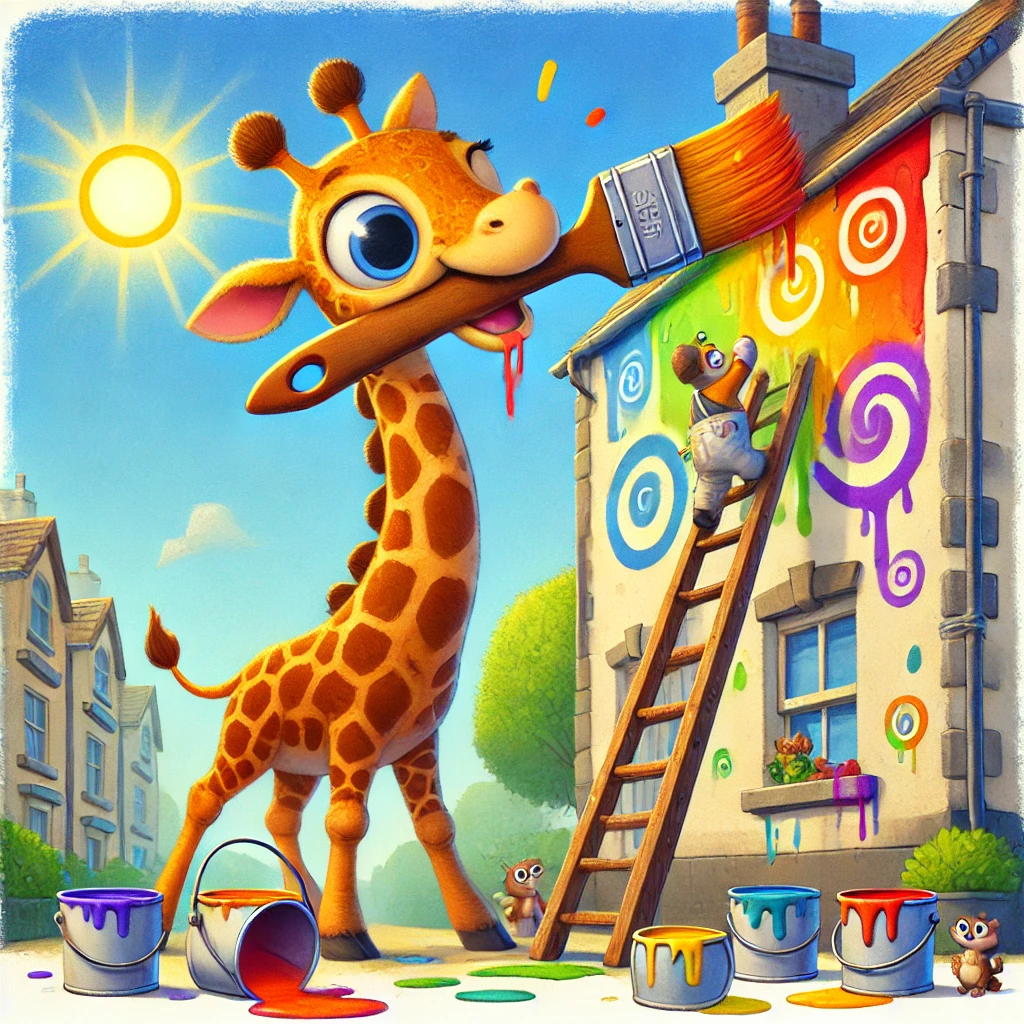Gerald
The Creative Moorhouse

The Giraffe Who Dreamed of Painting
Meet Gerald. Gerald isn’t your average giraffe. Sure, he’s got the long neck, the mottled spots, and the penchant for acacia leaves, but Gerald has aspirations beyond the savannah. You see, Gerald wants to be an artist—specifically, a painter.
Why, you ask? It all started when Gerald discovered that he could do something none of the other animals could: reach the eaves of the barn where Farmer Frank kept his paints. While other giraffes were content chomping on treetops and ignoring the human world below, Gerald found himself fascinated by the vibrant colors he saw smeared on the walls and canvases stored in the barn. He figured, “If I can reach the eaves, surely I’m destined to paint masterpieces.”
Gerald’s first foray into painting was… well, let’s call it “experimental.” He grabbed a paintbrush in his teeth, dipped it into a can of bright blue, and attempted a self-portrait on the side of the barn. Unfortunately, he sneezed halfway through, leaving an accidental but impressively abstract interpretation of a giraffe that looked more like a very tall, very sad alpaca.
The barn cat, Whiskers, walked by, took one look, and meowed something that sounded suspiciously like laughter. But Gerald wasn’t discouraged. “Art is subjective,” he thought. “Besides, Picasso probably sneezed too.”
As Gerald practiced, his technique improved. He learned to use his tail for broader strokes and his hooves for texture. Soon, his abstract barn paintings caught the attention of Farmer Frank’s kids, who thought they were the work of a reclusive human genius.
Word spread, and before long, Gerald’s “studio” (the barn) became the hottest art scene in the animal kingdom. Peacocks came for the aesthetics. Elephants brought their trunks full of snacks. Even the flamingos abandoned their usual one-legged stance to form an avant-garde dance circle around Gerald’s latest piece, a mural titled “Leaves of Majesty.”
With fame came challenges. Gerald was invited to exhibit at the Savannah Art Gala, an annual event hosted by the wildebeests. However, transporting a 14-foot-tall artist with a tendency to paint mid-journey was no easy task. By the time Gerald arrived, the zebra-drawn cart was covered in polka dots, much to the zebras’ dismay. “We’re stripes-only animals!” they brayed.
At the gala, Gerald’s works received mixed reviews. The lions found them “tasty-looking” (concerning), while the meerkats dubbed them “a neck above the rest.” But Gerald didn’t mind. He knew art wasn’t about pleasing everyone; it was about expressing yourself—even if that meant dripping paint all over the exhibit floor.
Gerald’s big break came when a visiting art critic from the city—a parrot named Pierre—discovered his work. Pierre, known for his flamboyant feathers and sharp eye for talent, declared Gerald’s art “the height of contemporary brilliance.” The news spread beyond the savannah, and soon, Gerald was receiving commissions from art collectors worldwide.
Gerald opened his own gallery, cleverly named The High Ground, where he created and showcased his masterpieces. His unique ability to paint murals on skyscrapers without scaffolding made him highly sought after in urban landscapes. City planners loved his eco-themed works, like the massive mural “Tree of Tomorrow” that now adorns the tallest building in Giraffeton.
But Gerald never forgot his roots—or the barn that started it all. He regularly hosted workshops for young, aspiring animal artists, teaching everything from brush control to finding inspiration in nature.
Today, Gerald’s murals can be seen across the savannah, from the waterhole’s edge to the termite mounds, and even in bustling metropolises. His style—a blend of giraffe grace and barnyard whimsy—has inspired countless animals to explore their own creative sides. The rhinos have taken up sculpting (with mixed results), and the parrots are now composing symphonies (heavy on the squawking).
Gerald taught us all an important lesson: Just because you’re a giraffe doesn’t mean you’re limited to eating leaves and looking majestic. Sometimes, you’re meant to paint the eaves—or at least, try and make the world a little more colorful while you’re at it.
